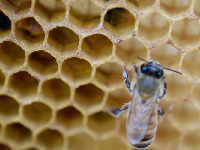Honeycomb construction

The hexagonal shape of honeycomb cells has long attracted scientists; however, the mechanism of the construction is still an open problem. There is an ongoing debate about how bees produce this precise hexagonal configuration. There are two general standpoints. One is that the precise structure is simply a result of the laws of physics. According to this view, rough structure made by honeybees get sophisticated by physical mechanisms such as surface tension. Note, however, that any wax flows which could influence the cell geometry have not observed yet. The other standpoint is that honeybees are exquisite engineers. Although honeybees possess a high intelligence, they do not build their nest under leader control or with any design diagrams: Their behavioral rules should be local and simple.

We consider that honeybees are engineers utilizing self-organization. Self-organization is a dynamic formation process in which higher-level order spontaneously arises out of local interactions among lower-level components. A leading example of self-organization is the formation of the Rayleigh–Bénard convection. An important point in the formation process is the balance between inflow and dissipation of energy. In honeycomb construction, self-organization could occur under the balance between supply and removal of wax. Worker honeybees supply wax by secretion, while elimination of wax in the construction process had not been recognized yet. A possible removal process is excavation by worker honeybees. We can connect the excavation to the construction process by adding an assumption that honeybees can detect the depth of the wax wall. Here, in order to understand honeycomb construction from a self-organization viewpoint, we have proposed an agent-based model, which we have named the attachment-excavation model. We have carried out numerical simulations of the attachment-excavation model to understand the ecology of honeybees.
Paper
T. Narumi, K.
Uemichi, H. Honda, and K. Osaki, short abstract of SWARM 2015
(2015).
T. Narumi, RIMS
Kôkyûroku 2043, 142 (2017).
[in Japanese]
T. Narumi, K.
Uemichi, H. Honda, and K. Osaki, PLoS ONE
13, e0205353 (2018).
T. Narumi, K.
Uemichi, H. Honda, and K. Osaki,
academist journal
(2019). [in Japanese]